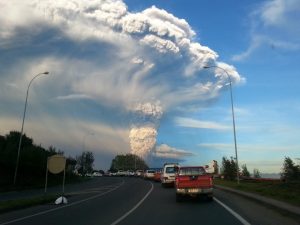14 March 2017
Volcanic eruption expanded ozone hole to record size
Posted by Nanci Bompey
By Brendan Bane

Calbuco erupts on April 22, 2015, sending clouds of volcanic, ozone-depleting aerosols into the atmosphere.
Credit: Aeveraal
On April 22, 2015, the Chilean volcano Calbuco erupted, spewing volcanic ash 10 kilometers (six miles) skyward. But Calbuco didn’t just tear a hole in the Earth that day. A new study suggests it also tore a hole in the sky.
The new study argues that Calbuco’s eruption stretched the Antarctic Ozone Hole — the thinnest portion of the ozone shell that shields Earth from harmful radiation — to a record size nearly as large as Africa. It did so by ejecting millions of tiny particles that eat away at the Earth’s ozone layer, according to the study published in Geophysical Research Letters, a journal of the American Geophysical Union.
The new study strongly supports a previous study identifying Calbuco as the likely driver of the expansion, said Diane Ivy, an atmospheric scientist at the Massachusetts Institute of Technology and lead author of the new study.
“The results between the two studies are similar, suggesting that chemical ozone depletion from Calbuco’s eruption led to the record ozone hole in 2015,” she said.
Ozone expansion
Researchers have tracked the ozone hole’s waxing and waning since its discovery in the 1980s. The hole was linked to the widespread use of ozone-depleting substances, and its discovery eventually sparked worldwide restrictions of such chemicals.
Researchers expected the hole, which forms in late September, to eventually shrink. But, instead, the ozone hole grew by 4.5 million square kilometers (1.7 million square miles) in October 2015, comparable to India swelling roughly to the size of Australia.
To know the cause behind the expansion, it’s important to understand Calbuco’s contribution, Ivy said.
“Understanding what caused the ozone hole to grow to such a large size is imperative to knowing whether it is recovering,” she said.
Researchers from the World Meteorological Organization originally suggested colder temperatures and reduced atmospheric circulation drove the expansion of the ozone hole in October 2015. But Susan Solomon, an atmospheric chemist also at the Massachusetts Institute of Technology and leader of the first research to describe the chemical mechanism behind anthropogenic ozone depletion, pointed to a different culprit: Calbuco’s massive 2015 eruption.
Suspecting Calbuco
Solomon authored a 2016 study published in Science suggesting Calbuco’s volcanic aerosols — tiny airborne particles formed by eruptions — had eaten away at the ozone layer.
When volcanos erupt, they spew clouds containing sulfur dioxide into the sky. The sulfur dioxide then condenses into particles, which dissipate and drift through the atmosphere. These particles tend to congregate back into clouds that hover over polar areas. The clouds provide a surface where chemical reactions ensue and ultimately deplete portions of the ozone layer.
But the new study, co-authored by Solomon, accounts for those changing conditions.
The new research models Earth’s ozone layer and its response to a sudden injection of volcanic aerosols, similar to those emitted by Calbuco. The simulations relied upon records of ozone-depleting substances and greenhouse gases from 1979 to 2015. The study’s authors ran two types of simulations: one with the injection of volcanic aerosols and another without the contribution of those particles.
The study’s authors found that, indeed, a sudden increase in volcanic aerosols could have depleted the ozone layer, strongly suggesting Calbuco was the cause of the ozone hole expansion.
Despite Calbuco’s contribution, the ozone hole does appear to be shrinking, Ivy said.
“We see signs of recovery when the ozone hole first starts to form in September,” she said.
— Brendan Bane is a freelance science writer.










 GeoSpace is a blog on Earth and space science, managed by AGU’s Public Information staff. The blog features posts by AGU writers and guest contributors on all sorts of relevant science topics, but with a focus on new research and geo and space sciences-related stories that are currently in the news.
GeoSpace is a blog on Earth and space science, managed by AGU’s Public Information staff. The blog features posts by AGU writers and guest contributors on all sorts of relevant science topics, but with a focus on new research and geo and space sciences-related stories that are currently in the news.